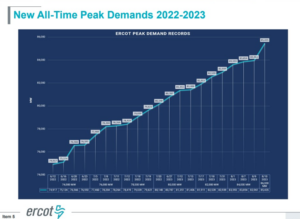ERCOT 2023 Mid-Year Electric Grid RECAP

2023 – Record Setting Temps and Record Peak Load Demand
Texas and the ERCOT grid experienced a long hot summer in 2023. The intense heat and load demand was record-setting throughout Texas. For instance, Austin saw 105+ degree temperature for 42 days this summer, breaking a record of 26 days set back in 2011; likewise, the overall Peak load demand on the grid saw 49 days over 80 gigawatts (GW), which was the all-time highest energy demand record set in July of 2022. The peak loads that Texas experienced during July and August were managed well with a strong combined performance from thermal generators, solar resources, wind resources and energy storage resources (batteries). Here are some key takeaways from this past summer which you need to be aware of.
New All-Time Peak Load Demand
As stated, the grid saw an increase in peak load demand from 2022, driven primarily by ‘economic load growth’ (industrial growth) as well as higher temperatures. In addition, this summer was drier and hotter than the prior year which contributed to the higher peak load demand that has drastically increased over the last two years.

Scarcity Period – Time of Day When Energy Supply and Load Demand Are the Tightest
Solar and wind generation now make up approximately 40% of the grid’s generation but solar generation alone has increased measurably from 2022. As a result, ERCOT saw the period when the grid is the tightest, commonly referred to as the scarcity period, shift to later in the day. Gross peak load demand from a year ago at the same time typically occurred around 3:00pm and 4:00pm, when the day was the hottest and electricity demand was the highest. This year, ERCOT saw the scarcity period shifted to 7:00pm or 8:00pm, as the grid was going through the solar ramp down period. Fortunately, ERCOT saw that the increased number of solar resources were able to accommodate the peak demand in the afternoon, but the grid reserves got tight when the heat remained into the evenings and the grid lost its solar energy.
Conservation Notices
Wind generation ramping up in the evenings was key to serving demand on most days, however low wind output was a leading factor on the day’s when conservation requests were issued. These conservation notices from ERCOT to the public were used to lower consumption and were effective in lowering demand during low wind conditions. ERCOT issued 11 conservation calls between June and September. ERCOT also stated that all available generation and ancillary services, or operating reserve generation services, were fully utilized during the high net load days when the wind was not performing as forecasted. Batteries were also effective and contributed to filling the gaps in supply of ancillary services to meet energy requirements.
Energy Emergency Alert – Used to Advise the Public About Energy Shortages On The Grid
The first new all-time peak demand record of 80.8 GW was reached in June. There were 10 new all-time peaks reached from June to August. The last all-time new peak demand record of 85.4 GW was reached on August 10th, a 5.4 GW increase from where it was in June. September 6th was not the highest peak load day, but it was tightest day for the grid all summer. There were transmission constraints from south Texas that forced thermal generation power plant outages that warranted the issuance of an Energy Emergency Alert (EEA) Level 2. An EEA Level 2 is issued when operating reserves have dropped below 1,750MW and are not expected to recover within 30 minutes. Level 3 is the most severe and could result in controlled outages. Higher temperatures, higher demand and insufficient resources in North and West Texas regions also led to transmission limitations in Central Texas which led to the EEA protocols described.
Higher Energy and Ancillary Prices
Comparatively, energy and ancillary service costs were higher this past Summer than the previous two summers, but the overall operations and market outcomes supported the grid reliability needs. The increase in cost was largely due to the increase in the amount of energy from ancillary services needed to manage the real-time operational risk under the current market conditions. There continues to be a need for additional ancillary services to the suite of operating reserve services because more energy is being served by intermittent resources which increases the risk of missing the forecast.
Ancillary services have specific operational purposes, and they are procured in an amount needed to manage those operational risks should large load or frequency come offline. They are not purchased or deployed specifically to influence wholesale prices, but are strictly reliability tools, deployed when needed to limit reliability risks on the system.
Looking ahead to Winter 2023-2024
As we have seen this summer, the grid has become more volatile with many variables like extreme weather and extreme load growth, as well as the early retirement of dispatchable power plants, which has led to more operational risks because the intermittent resources and shorter durations. These same factors will continue to challenge the grid in the winter months as well. ERCOT announced that they do not believe emergency conditions are likely to occur this winter, but they see an elevated risk probability and want to procure 3,000 MW of capacity to mitigate that risk. Again, considering the significant peak load growth since last winter and the extreme winter weather events experienced over the last two years, their analysis concluded a 20% probability of entering and Energy Emergency Alert during the highest risk hours. The additional 3,000 MW capacity is the estimate capacity needed to meet the load and operating reserve requirements during a winter weather event.
The complexity of managing a growing demand and a dynamic load environment in Texas becomes more challenging for the grid operators today that it has ever been. Although much of the focus has been on the supply side of the equation, ERCOT is also looking at the transmission and demand side of the equation to alleviate congestion constraints and reduce load demand. A holistic approach must be taken to meet load requirements and maintain a comfortable operating reserve margin moving forward.


